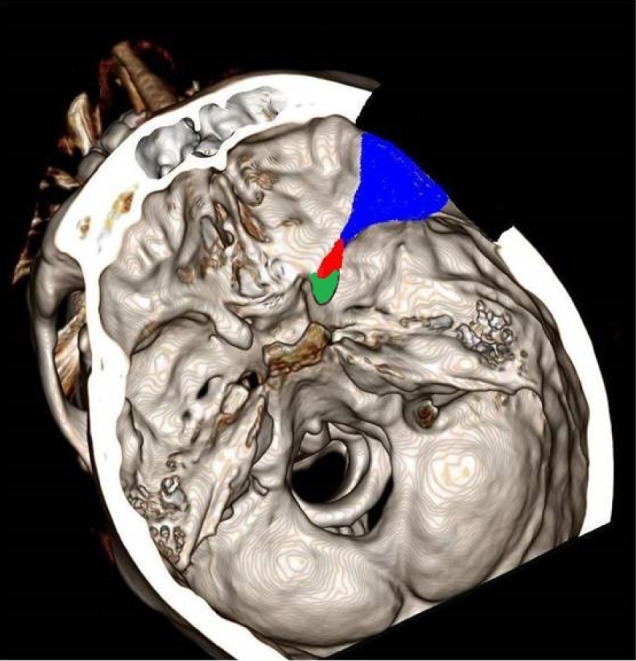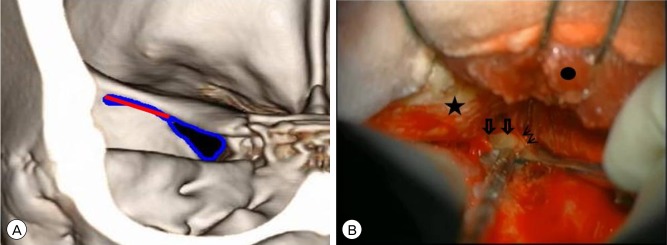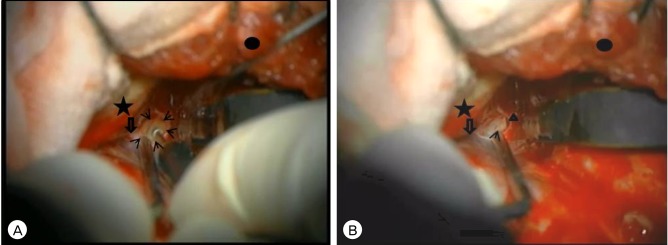J Cerebrovasc Endovasc Neurosurg.
2013 Sep;15(3):260-266. 10.7461/jcen.2013.15.3.260.
The Pterional Approach and Extradural Anterior Clinoidectomy to Clip Paraclinoid Aneurysms
- Affiliations
-
- 1Department of Neurosurgery, Haeundae Paik Hospital, Inje University Colleage of Medicine, Busan, Korea. nssunlee@inje.ac.kr
- KMID: 1491450
- DOI: http://doi.org/10.7461/jcen.2013.15.3.260
Abstract
OBJECTIVE
The surgical clipping of paraclinoid segment internal carotid artery aneurysms is considered difficult because of the complex anatomical location and important neighboring structures. Our experiences of pterional craniotomy and extradural anterior clinoidectomy (EAC) to clip paraclinoid aneurysms are reported herein.
METHODS
We present two patients with paraclinoid aneurysms who underwent surgical clipping using pterional craniotomy and EAC. The clinical results and operative techniques were reviewed from the patients' medical records.
RESULTS
EAC improves the surgical field in the suprasellar and periclinoid regions. Clinically, a good outcome was obtained in both cases. No surgical complications directly resulting from the EAC were observed.
CONCLUSION
Favorable surgical results can be obtained with pterional craniotomy and EAC for the clipping of paraclinoid aneurysms. EAC is advocated for the clipping of paraclinoid aneurysms.
MeSH Terms
Figure
Reference
-
1. Chi J, Sughrue M, Kunwar S, Lawton M. The "yo-yo" technique to prevent cerebrospinal fluid rhinorrhea after anterior clinoidectomy for proximal internal carotid artery aneurysms. Neurosurgery. 2006; 7. 59(1 Suppl 1):ONS101–ONS107. discussion ONS101-7. PMID: 16888539.
Article2. Dolenc VV. A combined epi- and subdural direct approach to carotid-ophthalmic artery aneurysms. J Neurosurg. 1985; 5. 62(5):667–672. PMID: 3989589.
Article3. Evans JJ, Hwang YS, Lee JH. Pre-versus post-anterior clinoidectomy measurements of the optic nerve, internal carotid artery, and opticocarotid triangle: A cadaveric morphometric study. Neurosurgery. 2000; 4. 46(4):1018–1021. discussion 1021-3. PMID: 10764284.4. Inoue T, Rhoton AL Jr, Theele D, Barry ME. Surgical approaches to the cavernous sinus: A microsurgical study. Neurosurgery. 1990; 6. 26(6):903–932. PMID: 2362670.
Article5. Rhoton AL Jr. The anterior and middle cranial base. Neurosurgery. 2002; 10. 51(4 Suppl):S273–S302. PMID: 12234451.
Article6. Romani R, Elsharkawy A, Laakso A, Kangasniemi M, Hernesniemi J. Complications of anterior clinoidectomy through lateral supraorbital approach. World Neurosurg. 2012; May-Jun. 77(5-6):698–703. PMID: 22120307.
Article7. Romani R, Elsharkawy A, Laakso A, Kangasniemi M, Hernesniemi J. Tailored anterior clinoidectomy through the lateral supraorbital approach: Experience with 82 consecutive patients. World Neurosurg. 2012; Mar-Apr. 77(3-4):512–517. PMID: 22120327.
Article8. Romani R, Kivisaari R, Celik Or, Niemela M, Perra G, Hernesniemi J. Repair of an alarming intraoperative intracavernous carotid artery tear with anastoclips: Technical case report. Neurosurgery. 2009; 11. 65(5):E998–E999. discussion E999. PMID: 19834393.
Article9. Son HE, Park MS, Kim SM, Jung SS, Park KS, Chung SY. The avoidance of microsurgical complications in the extradural anterior clinoidectomy to paraclinoid aneurysms. J Korean Neurosurg Soc. 2010; 9. 48(3):199–206. PMID: 21082045.
Article10. Yasargil MG, Gasser JC, Hodosh RM, Rankin TV. Carotid-ophthalmic aneurysms: Direct microsurgical approach. Surg Neurol. 1977; 9. 8(3):155–165. PMID: 897986.11. Yonekawa Y, Ogata N, Imhof HG, Olivecrona M, Strommer K, Kwak TE, et al. Selective extradural anterior clinoidectomy for supra- and parasellar processes. Technical note. J Neurosurg. 1997; 10. 87(4):636–642. PMID: 9322855.12. Yoon BH, Kim HK, Park MS, Kim SM, Chung SY, Lanzino G. Meningeal layers around anterior clinoid process as a delicate area in extradural anterior clinoidectomy: Anatomical and clinical study. J Korean Neurosurg Soc. 2012; 10. 52(4):391–395. PMID: 23133730.
- Full Text Links
- Actions
-
Cited
- CITED
-
- Close
- Share
- Similar articles
-
- The Avoidance of Microsurgical Complications in the Extradural Anterior Clinoidectomy to Paraclinoid Aneurysms
- The Usefulness of Extradural Anterior Clinoidectomy for Lower-Lying Posterior Communicating Artery Aneurysms : A Cadaveric Study
- Internal Carotid Artery Reconstruction Using Multiple Fenestrated Clips for Complete Occlusion of Large Paraclinoid Aneurysms
- Pre -vs. Post-Anterior Clinoidectomy Measurements of the Optic Nerve, Internal Carotid Artery, and Optico-Carotid Triangle: A Cadaveric Morphometric Study
- Large and Giant Paraclinoid Aneurysms Treated by Combined Extradural and Intradural Approach






